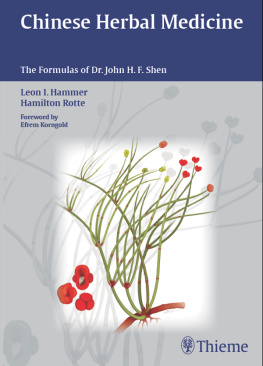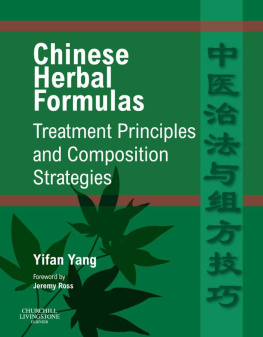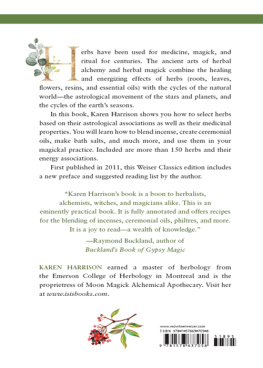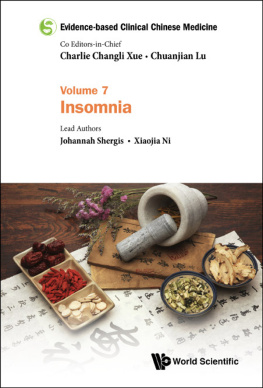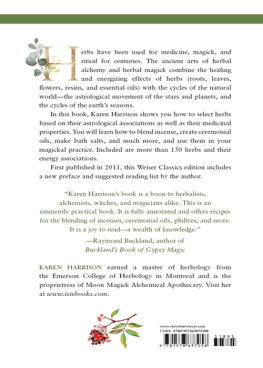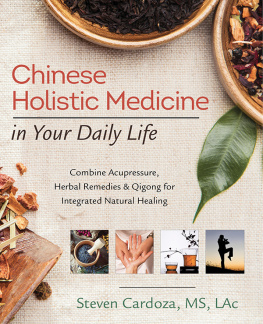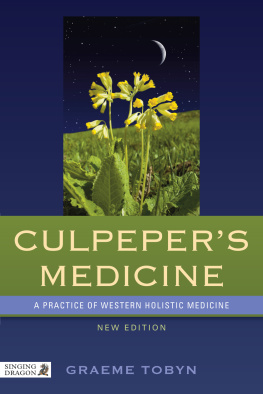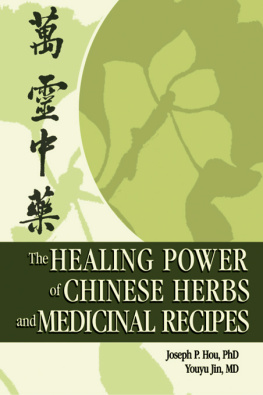Chinese Herbal Medicine
The Formulas of Dr. John H.F. Shen
Leon I. Hammer, MD
Founder
Dragon Rises College of Oriental Medicine
Gainesville, Florida
USA
Hamilton Rotte, MSTCM, AP
Dragon Rises College of Oriental Medicine
Gainesville, Florida
USA
With contributions by
Ray Rubio, DAOM, LAc, FABORM
24 illustrations
Thieme
Stuttgart New York
Library of Congress Cataloging-in-Publication Data is available from the publisher.
Illustrator: Laisha Canner, AP, MAOM, Gainesville, Florida, USA
2013 Georg Thieme Verlag KG,
Rdigerstrasse 14, 70469 Stuttgart, Germany
http://www.thieme.de
Thieme Medical Publishers, Inc., 333 Seventh Avenue,
New York, NY 10001, USA
http://www.thieme.com
Cover design: Thieme Publishing Group
Typesetting by SOMMER media GmbH & Co. KG,
Feuchtwangen, Germany
Printed in Germany by Grafisches Centrum Cuno, Calbe
ISBN 978-3-13-150071-7
eISBN 978-3-13-169721-9
Important note: Medicine is an ever-changing science undergoing continual development. Research and clinical experience are continually expanding our knowledge, in particular our knowledge of proper treatment and drug therapy. Insofar as this book mentions any dosage or application, readers may rest assured that the authors, editors, and publishers have made every effort to ensure that such references are in accordance with the state of knowledge at the time of production of the book.
Nevertheless, this does not involve, imply, or express any guarantee or responsibility on the part of the publishers in respect to any dosage instructions and forms of applications stated in the book. Every user is requested to examine carefully the manufacturers? leaflets accompanying each drug and to check, if necessary in consultation with a physician or specialist, whether the dosage schedules mentioned therein or the contraindications stated by the manufacturers differ from the statements made in the present book. Such examination is particularly important with drugs that are either rarely used or have been newly released on the market. Every dosage schedule or every form of application used is entirely at the users own risk and responsibility. The authors and publishers request every user to report to the publishers any discrepancies or inaccuracies noticed. If errors in this work are found after publication, errata will be posted at www.thieme.com on the product description page.
Some of the product names, patents, and registered designs referred to in this book are in fact registered trademarks or proprietary names even though specific reference to this fact is not always made in the text. Therefore, the appearance of a name without designation as proprietary is not to be construed as a representation by the publisher that it is in the public domain.
This book, including all parts thereof, is legally protected by copyright. Any use, exploitation, or commercialization outside the narrow limits set by copyright legislation, without the publishers consent, is illegal and liable to prosecution. This applies in particular to photostat reproduction, copying, mimeographing, preparation of microfilms, and electronic data processing and storage.
Foreword
Numerous schools of thought and various methods are found within the vast historical tradition of Chinese medicine
It sustains itself in part by adjusting to changing conditions and will continue to develop differently in each country and era in relation to the social demands and belief systems that prevail there.
(Beinfield H, Korngold, E. Between Heaven and Earth: A Guide to Chinese Medicine. New York: Ballantine; 1991:xiv)
Chinese medicine was just beginning to join the greater social, cultural, and medical landscape of US health care in the 1980s. Only a few acupuncture colleges were established by this time in the coastal cities in which the largest Chinese immigrant communities had settled a century earlier.
Doctors from China began immigrating to the United States in the mid-1970s to become licensed acupuncture practitioners. They brought with them practical experience and systematic training in both conventional Western medicine and what is now known as Traditional Chinese Medicine or TCM. Formulated in the 1950s, TCM was the product of a government initiative to reexamine, reframe, homogenize, and standardize traditional medical knowledge in accord with the principles of modern scientific medicine and the prevailing political ideology of China. TCM is a 20th-century reinvention.
In the last 20 years, US students, teachers, practitioners, and researchers have been gaining a greater appreciation of the enormously diverse historical currents in Chinese traditional health carethanks primarily to the work of Western scholars who have published the results of their anthropological, historical, and linguistic investigations. As a result, we are beginning to fathom, value, and gain access to knowledge transmitted over generations by families and communities outside of and in parallel with officially approved Chinese medical curricula.
Dr. John Shen was initiated into a 17th-century medical tradition known as the Menghe lineage. In 1971 he brought this knowledge tradition with him to the United States. Not only was he a transporter of the Menghe current, he was himself an ingenious innovator who readily tailored what he knew to the conditions and the people he encountered here. I believe that he saw in Leon Hammer an enlightened physician devoted to seeking the comprehension and skill that would enable him to be ever more efficacious in his medical mission.
No doubt it was Dr. Hammers ardent pursuit of Chinese medicine teachings that led him, as if by chance, to an encounter with Dr. John Shen in the early 1970s. The result of this fortuitous meeting between men with entirely different cultural and medical backgrounds is that we are offered an entre into the Menghe current. The opportunity to explore, incorporate, and shape this tradition of knowledge and practice to the context of our lives is ours to choose. In accepting this offer, are we not called upon to develop our own current and our own tradition? I believe this is what Drs. Shen and Hammer had in mind.
Because of his diligence, perseverance, fertile imagination, and critical intelligence, Leon Hammer recognized the authenticity of John Shens insight and the depth of his skill. He was determined to acquire and absorb as much as he could and then pass it on to the rest of us. Along with his studentsand I am proud to be oneand the teachers he has trained, he has made Dr. Shens method of pulse diagnosis comprehensible and teachableno small feat!
With this book, Leon Hammer and Hamilton Rotte generously share the bounty of Dr. Shens herbal prescriptions. Rottes adept analysis of their contents, indications, and conceptual foundation makes this an eminently practical clinical guide. These formulas are now available for us as inspiration, to study and to put to good use.
Efrem Korngold, OMD, LAc
Preface
The Herbal Heritage of Dr. John H. F. Shen
This book has been organized and written by Hamilton Rotte, MSTCM, AP, and Leon I. Hammer, MD. Hamilton Rotte is a graduate of the American College of Oriental Medicine in San Francisco, a member of the faculty and previously Clinical Director at Dragon Rises College of Oriental Medicine (DRCOM, www.dragonrises.edu), and an herbalist and teacher. Analysis of the formulas, a larger part of this book, is written by Hamilton Rotte. There are denoted by a gray sidebar and the appellation Hamilton Rotte. Many of the etiologic, diagnostic comments and references to Dr. Shens concepts are by Dr. Hammer. The latter are denoted by a red sidebar and the appellation Leon Hammer and are repeated for each formula for which they are appropriate. The illustrations were provided by Laisha Canner, AP, a faculty member at Dragon Rises College of Oriental Medicine.
Next page
